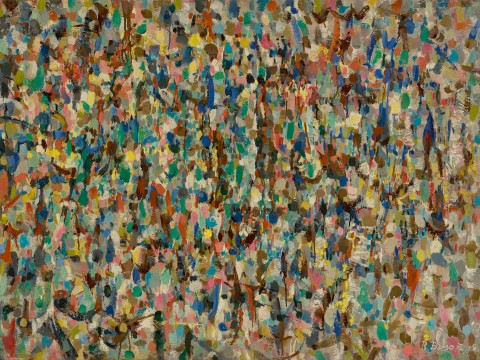NON-OBJECTIVE PAINTING, 1958
RALPH BALSON
oil on composition board
76.0 x 100.5 cm
signed and dated lower right: R Balson. 58.
Private collection
Christie’s, Melbourne, 6 March 1970, lot 101 (as ‘Abstract’)
The National Australia Bank Art Collection (label attached verso)
Non-Objective Painting was completed in 1958, a particularly auspicious year in Australian abstract painter Ralph Balson’s period of the same name. This series of paintings, in opposition to the geometric works that had preceded them, consisted of veils of carefully dappled and modulated colour, evenly spread all-over the hardboard support. Many of the best examples of this distinctive style, all dating from late 1950s, were acquired for public collections, including Painting, 1957 (National Gallery of Australia); Painting, 1958 (Art Gallery of New South Wales); Non-Objective Painting, 1958 (Art Gallery of South Australia); and Non-Objective Painting, 1958 (National Gallery of Victoria).
Throughout his career, Ralph Balson tirelessly sought a process of abstract painting that would respect the physical qualities of paint while illustrating what he would call the ‘ineffable’: the sublime and invisible forces of the universe.1 This pursuit led him through a disciplined, logical progression of different styles of abstract painting – from the planar geometry of his ‘Constructive’ works, to painterly fragmentation in the ‘Non-Objective’ paintings, and finally, the poured ‘Matter Paintings’. In 1955, corresponding with a change in personal circumstance, Balson was finally liberated from the impersonal rigour of his previous styles and allowed himself to embrace the ever-changing fluidity of the universe, in the form of abstract impressionism. The fact that Balson would later return to this style in the final years of his life attests to his appreciation of its artistic resolution and its singular ability to encapsulate his radical ideas. While Balson was notably well-read in the developments of international abstract art, in particular American Action Painting and European tachisme, the density and fluidity of his non-objective surfaces instead sought to emulate in paint the experimental stream-of-consciousness literary style of James Joyce.2
The dramatic adoption of a fractured, kaleidoscopic surface was prefigured in Balson’s pastel works on paper, which were first exhibited at Macquarie Galleries in Sydney in 1952. James Gleeson described these works on paper as a ‘descent into a fantastic and delightful jungle […] forms are shattered into a thousand particles which are disposed over the surface in patterns of great complexity and variety.’ 3
This Non-Objective Painting represents a vision of the infinite through a complex and vibrant web of layered staccato marks. With a wide variety of brushstrokes, Balson has distributed the colours throughout this composition with the utmost care, associating unexpected colour variations and variating brushstroke orientation to create a delicate vibrating motion. With no clear focal point, the marks of the finely mottled surface coalesce in the centre and dissipate towards the edges of the support. The eye is drawn around the painting, attracted by joyful and bold tonal associations, such as stippled highlights of white, cobalt and cadmium red, or dashes of burnt umber subtly dripping beneath lighter and brighter daubs. Non-Objective Painting is a superb example of Balson’s impressionist and increasingly gestural interpretation of the underlying fabric of the universe.
While he remained for most of his life quietly removed from the social scene of the Sydney art world, examples of Balson’s works were featured in major collections and exhibitions during his lifetime. It was in the early 1970s, however, thanks to the efforts of Grace Crowley, the artist’s son William Balson, art historians Daniel Thomas and Bernard Smith, and the crucial memorial exhibitions presented at Sydney’s Gallery A, that an appreciation of Balson’s role in Australian art was consummated. The second memorial exhibition in 1967 presented at Gallery A included no fewer than thirty examples of Balson’s Non-Objective paintings.4 The acquisition of Non-Objective paintings by the NGV, AGNSW, AGSA and NGA were all made between 1968 and 1973, and at the forefront of fashion, this example was acquired for the National Australia Bank collection in March 1970.
1. Adams, B., ‘Metaphors of Scientific Idealism: The theoretical background to the paintings of Ralph Balson’ in Bradley, A. and Smith, T. (eds.), Australian Art and Architecture: Essays presented to Bernard Smith, Oxford University Press, Melbourne, 1980, p. 188
2. Balson, 1956, Pacific Loan exhibition catalogue, in Thomas, D., 'Ralph Balson', Art and Australia, vol.2, no.4, Sydney, March 1965, p. 258
3. Gleeson, J., ‘Abstract Art Show Exciting’, The Sun, Sydney, 21 May 1952, p. 48
4. Thomas, D., ‘Ralph Balson and Gallery A’, Gallery A Sydney 1964 – 1983, Campbelltown Arts Centre, New South Wales, 2009, p.106
LUCIE REEVES-SMITH
